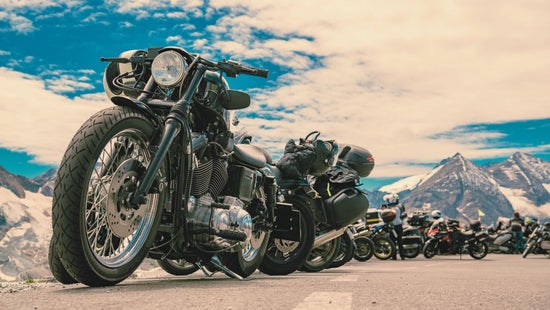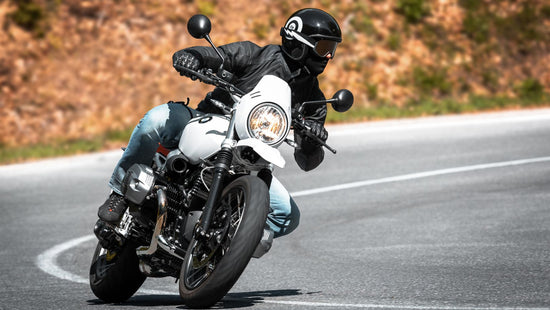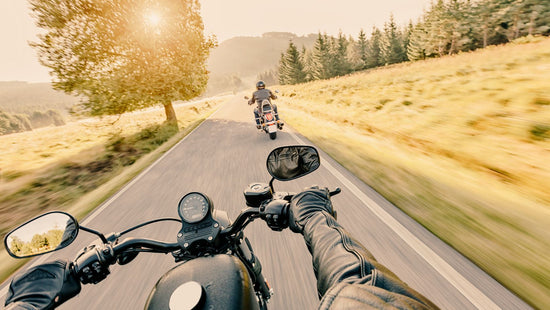

As bikers, we are no strangers to the excitement of hitting the road, but when the rain starts pouring, it's crucial to adjust our riding techniques for our safety. Although there are some motorcyclists, who enjoy motorcycle riding in the rain, for most of us, it is just an unpleasant byproduct of commuting and motorcycle trips. In this blog post, we will explore the necessary precautions to take, what to expect, how to adjust your riding technique, and how much tire grip you can expect to lose. So, fasten your helmet and get ready to tackle the rain while staying safe and in control.
Introduction
The potential loss of traction, reduced visibility, and the overall wet and slippery conditions make riding in the rain a common concern for riders, especially for beginners and intermediates. However, with the right precautions and adjustments in riding technique, you can confidently navigate the rain and still enjoy your ride.
Is it Safe to Ride Motorcycle in the Rain?
Factors to consider before deciding to ride in the rain
Before we dive into the tips and techniques for motorcycle riding in the rain, let's address the question of whether it is safe to ride in wet conditions. Well, it is always gonna be more dangerous than riding in dry conditions. You can address internal factors that are under your control like your motorbike riding skills or tyre condition, but the rain affects other drivers, their visibility and traffic as a whole, which naturally puts more pressure on your safety.
First and foremost, check the weather forecast before you set out on your ride. If heavy rain, thunderstorms, or any other severe weather conditions are expected, it is best to postpone your ride. Safety should always be your top priority.
If the rain is light to moderate, and you still decide to ride, make sure you have the appropriate gear. A good quality waterproof motorcycle jacket, pants, and gloves are essential to keep you dry and comfortable. Additionally, consider wearing a full-face helmet with a clear visor or a helmet with a Pinlock system to prevent fogging and maintain visibility.
Precautions to Take
Before you start your ride, there are a few precautions you should take to ensure your safety:
1. Check your motorbike tyres: Make sure your tyres are in good condition and properly inflated. Worn-out tires with low tread depth can significantly reduce traction on wet surfaces, increasing the risk of skidding or sliding. During the rain is the only time you really need your tyre tread, but at this time it’s crucial to push the water away from under your wheel to prevent aquaplaning. Correct tyre pressure should always be your goal, but in the rain, it just becomes even more important, as your tyre grip is under more stress.
2. Turn on traction control if your motorcycle has one, to help you with preventing too much power to the rear wheel. It is more about your wrist and smooth throttle control, but an electronic assistant can be a good helper in the rain.
3. Be visible: In rain, visibility is crucial for both you and other drivers on the road. Wear brightly colored or reflective gear to increase your visibility. I am not a great fan of bright high visibility vests and helmets, bikers should look cool and bright green or orange is not cool. But rainy and low visibility weather is a good time to put on your vest or high visibility straps.

Adjusting Riding Technique for Wet Conditions
Remember, that roads might be especialy slippery right after it started raining, especially when it hasn’t rained in a long time. The water just makes the oil and gas debris from the vehicles into a slippery mess. After it has rained for a while, the smudge should have washed off already and you can be more confident in your tyre grip.
The sources are inconsistent about how much grip you really lose in wet conditions ranging from 10 to 50%. It is safe to assume that your grip will be about one third weaker, so you need to adjust your motorbike riding accordingly:
1. Slow down: Wet surfaces reduce traction both in cornering and extend stoping distance, so it is important to reduce your speed when riding in the rain. Start by riding at a slower pace than you normally would and maintain a safe following distance from other vehicles.
2. Brake and accelerate gently: Sudden braking or acceleration can cause your tyres to lose grip on wet surfaces, leading to skidding or sliding. Apply the brakes and throttle smoothly and gradually to maintain control. Smoothness is the key to riding in the rain. Avoid sudden grabbing of your front brakes, instead squeeze it gradually. Avoid sudden jerking of the throttle, instead be very smooth and steady both rolling on and off the throttle.
3. Avoid puddles and watch for painted lines and tram tracks: Puddles can hide potholes or other hazards, and painted lines on the road can become extremely slippery when wet, same as tram or train tracks. You do not want to learn this the hard way like many riders who have not been told. When riding in the city, painted lines and tracks become very slippery when wet, because they are very smooth. This results in very low traction, so ride over them in a straight line, avoid any lean angles.
Another tricky spot to watch ou for are underground garages. Their floors are painted and very smooth and the cars will bring the water inside on rainy days.
4. Lean angle and body position: Since your motorcycle will lose part of the traction in the rain, it is wise to adjust your lean angles and not to lean your motorcycle the same way you would on dry surface. Smaller lean angle means less speed or shifting more body weight into the turn. On the wet surface is when proper motorcycle riding position really comes into play. Keep your motorbike more upright but use your upper body to shift the center of combined gravity of yourself and the motorcycle into the turn as much as possible.
5. Be mindful of hydroplaning: Hydroplaning occurs when your tires lose contact with the road surface due to a layer of water. To prevent hydroplaning, avoid riding in the wheel tracks of other vehicles, as they tend to accumulate more water. Additionally, avoid sudden steering movements or abrupt changes in direction.
6. Read the traffic and apply defensive motorbike riding techniques: You might do everything correct, but other drivers might be struggling with the rain too. Be extremely cautious about car drivers' behavior. Their vision and hearing is affected as much as their braking power. Always try to put yourself in the best possible and safest position applying defensive motorbike riding techniques and do not assume that they see you.
Cornering and handling curves in the rain
When cornering in the rain, the same principles and techniques apply as if riding on the dry road. They just become more important and your mistakes magnified by the wet conditions. With the right techniques, you can navigate the curves safely. Here are some tips to keep in mind:
1. Slow down before entering a curve: Reduce your speed before entering a curve to maintain control and prevent skidding. Remember that your tires have less grip on wet surfaces, so take it easy.
2. Keep a consistent throttle: When cornering in the rain, it's important to maintain a steady throttle throughout the turn. Abrupt throttle changes can cause your tires to lose traction and lead to instability.
3. Use smooth and gentle inputs: Avoid sudden braking or accelerating while in the middle of a curve. Smooth and gradual inputs will help maintain traction and stability. Plan your braking and acceleration before entering the curve.
4. Optimize your line: In wet conditions, it's best to take a wider line through the curve. This allows for a larger turning radius, reducing the risk of sliding or skidding. Stay away from the inside line, as it may have more oil and debris.
5. Look through the curve: Keep your eyes focused on where you want to go, rather than fixating on the immediate path ahead. This will help you maintain balance and control while navigating the curve.
6. Be prepared for unexpected hazards: Wet roads can hide potholes and other obstacles. Stay alert and be ready to make adjustments if necessary. Avoid sudden swerves or panic braking, as they can lead to loss of control. Always leave yourself some room to adjust your lane or lean angle, don’t ride your motorcycle close to the limit.
Conclusion
In conclusion, riding a motorcycle in the rain requires extra caution and adjustments to your motorbike riding technique. It's important to be aware of the reduced grip on wet surfaces and take appropriate measures to ensure your safety. By slowing down before entering curves, maintaining a consistent throttle, using smooth inputs, optimizing your line, and staying alert for unexpected hazards, you can navigate the rain with confidence. Remember, always prioritize your safety and be mindful of other drivers on the road. With the right knowledge and proper techniques, riding in the rain can still be an enjoyable and safe experience. Stay safe and keep riding!
Are there techniques for cornering safely while riding a motorcycle in the rain?
First and foremost, before you even think about hitting those corners, make sure you have the appropriate gear. Invest in a good quality rain suit that is waterproof and fits you well. This will not only keep you dry but also help to maintain your concentration on the road. Additionally, wearing proper motorcycle boots with good grip and using anti-fog visors will enhance your visibility and control while riding in the rain. When it comes to cornering in wet conditions, your main focus should be on maintaining a smooth and controlled approach. Reduce your speed before entering the corner and give yourself plenty of time and space to adjust your line. This means braking gently and progressively before the turn, rather than making sudden or aggressive movements. Next, let's talk about body position. While cornering in the rain, it's essential to shift your weight to the inside of the turn. This will help to maintain balance and provide better traction. Keep your body and head upright and try to maintain a relaxed grip on the handlebars. Avoid any sudden movements or jerks, as this can upset the stability of the motorbike and lead to a loss of control. Another key technique for cornering safely in the rain is to maintain a consistent throttle. Smooth and gradual acceleration throughout the corner will help to maintain traction and prevent wheel spin. Avoid sudden throttle inputs that can cause the rear wheel to break loose and result in a loss of control. In addition to these techniques, it's important to be aware of the road conditions and adjust your riding style accordingly. Rain can create slippery surfaces, so expect to experience a decrease in tire grip. It's important to give yourself more space and time to maneuver, as braking distances will be longer and it will take longer for the tires to regain traction after a turn. Speaking of tyres, it's worth mentioning that different tires have different levels of grip in wet conditions. Some tires are specifically designed for better traction in the rain, so it's a good idea to invest in high-quality tires that provide good wet weather performance. Checking your tire tread depth and maintaining proper tire pressure are also important for optimal grip in wet conditions. Lastly, always be vigilant and stay alert for unexpected hazards on the road. Rain can wash away debris and make road markings less visible, so be prepared for potential obstacles or slippery spots. Keep a safe distance from other vehicles and be mindful of their movements as well.
How much motorcycle tyre grip will I lose in the rain?
It's important to note that riding in the rain will inevitably lead to a decrease in tire grip. The amount of grip you'll lose depends on various factors such as the condition of your tires, the type of road surface, and the intensity of rainfall. On average, you can expect to have around 20-30% less grip in wet conditions compared to dry conditions.












